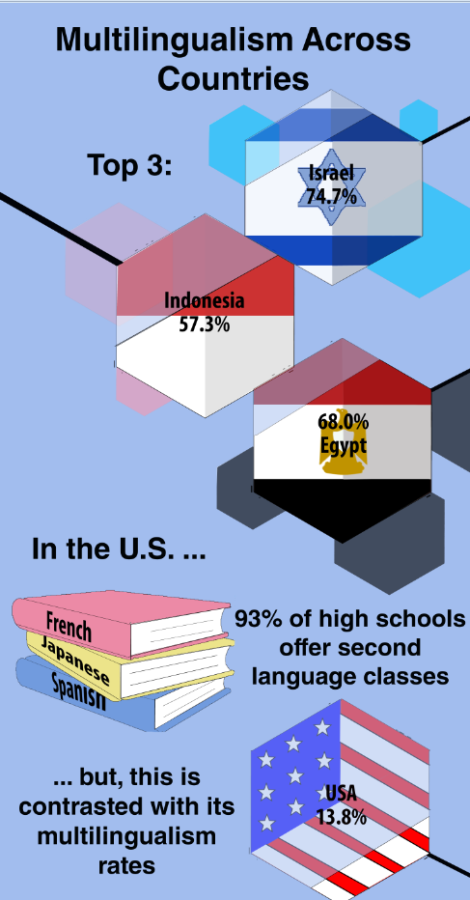The effects of multilingualism on the brain
September 28, 2017
While there are currently over 6900 languages in the world, the vast majority of the U.S. population is fluent only in English, with the rate of bilingualism rate under 20 percent. Over half of the world’s population, however, is composed of polyglots, people who can speak multiple languages. In the 20th century, there was a widely held belief that being multilingual was a mental distraction for students. However, this view has dramatically changed since then, and as of 2008, 93 percent of high schools in the U.S. offer second language classes. High school students are encouraged, if not required, to take these classes in an attempt to increase the multilingualism rate.
Multilingualism, the ability to speak multiple languages, is a skill that many countries incorporate into school curriculum to expose students to new cultures. Besides having profound social benefits, speaking multiple languages has proven to have positive mental effects as well. Numerous studies have been published in recent years that indicate the mental health benefits of being multilingual from a young age, ranging from a nimbler mind to a faster stroke recovery.
“Multilingualism is a true gift,” said Spanish teacher Michael Esquivel. “Learning a language is so much more than vocabulary and grammar. It’s a culture which is an umbrella term for religion, pop culture, politics and actors. Learning another language opens up the door to so many ‘ah-ha’ moments.”
Polyglots often have to switch languages depending on the situation they are in, requiring them to be more perceptive to their surroundings. A study conducted at the University of Pompeu Fabra had German-Italian bilinguals and Italian monolingual execute various tasks. The researchers found that the bilinguals executed the tasks better with less activity detected in their brains, suggesting that bilinguals could be more efficient at multitasking.
Apart from enjoying better multitasking and problem solving skills, multilinguals may also have valuable health benefits. A study of Spanish-English bilinguals at the University of California, San Diego concluded that people with a higher proficiency in multiple languages were able to resist the symptoms of dementia and Alzheimer’s disease for longer periods of time. Because als have more brain matter, a beneficial trait if the brain were to succumb to a disease like dementia. Another study published in a journal of the American Heart Association on stroke survivors showed that bilinguals were about twice as likely to recover from brain damage resulting from strokes than monolinguals were.
Studies conducted by the Multilingual Children’s Association showed that children raised in multilingual households had more superior analytical and social skills than their monolingual peers do. This can be partially attributed to the greater amount of processing skills needed to understand multiple languages. When spoken to in several languages at a young age, infants tend to develop greater processing skills. Additionally, exposure to a broader range of vocabulary, sounds and grammar gives multilingual children an advantage when learning another language, due to an effect called positive transfer, which refers to using familiar sounds and grammar structures and applying them to a new language.
“I think learning Chinese has helped me pick up words and phrases I’ve heard from other people in different languages,” said junior Selina Li. “For instance, I’ve learned a lot of Chinese colloquialisms from my parents because they use them in everyday life, not because I was taught them.”
Even though foreign language classes may require a great deal of effort for some students, new research concerning the variety of mental and spatial advantages of being a polyglot, combined with the social benefits of knowing multiple languages, makes the time investment of learning additional languages worth it in the long run.



































































